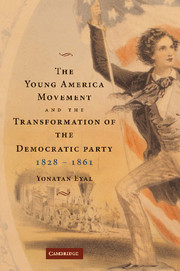Book contents
- Frontmatter
- Contents
- Acknowledgments
- Introduction: The Spirit of Young America
- 1 Orthodox Jacksonianism, 1828–1844
- 2 Trade and Improvements: The Economic Orientation of Young America Democrats
- 3 Rails, Canals, and a New Commercial Spirit
- 4 Young America Democrats and the Revolutions of 1848
- 5 A New International Consciousness
- 6 The Fires of Perfection Revisited
- 7 The Antislavery Democracy
- 8 New Democrats and the Coming of the Civil War
- Conclusion: Lincoln on Young America
- Index
Introduction: The Spirit of Young America
Published online by Cambridge University Press: 31 July 2009
- Frontmatter
- Contents
- Acknowledgments
- Introduction: The Spirit of Young America
- 1 Orthodox Jacksonianism, 1828–1844
- 2 Trade and Improvements: The Economic Orientation of Young America Democrats
- 3 Rails, Canals, and a New Commercial Spirit
- 4 Young America Democrats and the Revolutions of 1848
- 5 A New International Consciousness
- 6 The Fires of Perfection Revisited
- 7 The Antislavery Democracy
- 8 New Democrats and the Coming of the Civil War
- Conclusion: Lincoln on Young America
- Index
Summary
In 1853, New York writer and lecturer George William Curtis tried to put into words the elusive mindset known as Young America. Curtis attempted to define a concept that had many meanings in the antebellum United States, and in his speech he focused on its spirit of freshness and boldness. “Youth, or Young America, smiles at greatness,” he observed.
It confidently expects to exceed and rival in greatness, “the noblest Roman of them all.” It says “well done” to Alexander, and pats Hannibal on the back; it smiles patronizingly on Julius Caesar, and will acknowledge Homer to be a good poet, if you insist upon it; and even admits that, at present, two and two make four. But it is secretly convinced that all these works of antiquity are only partial and incomplete affairs, not to be compared with what can be done in our day, and resolves that the time shall come when two and two shall make five.
The Young American “prowls about Cuba,” he continued, “seeking how he may devour it, and sends Commodore Perry to Japan, with the very pleasant message that he is the sun, that the moon is his wife, and the earth their heritage.” This assessment only barely exaggerated the quest for novelty that lay at the heart of the Young America ethos.
Curtis's contemporaries came to similar conclusions about Young America. The Democratic Review, a partisan journal of polite letters, best encapsulated its ethos through poetry:
Wherever Action leaves the past, and brings the future near –
Where'er electric progress leaps from customs cloudy sphere – […]
- Type
- Chapter
- Information
- Publisher: Cambridge University PressPrint publication year: 2007



